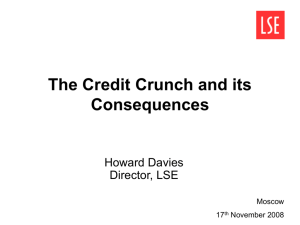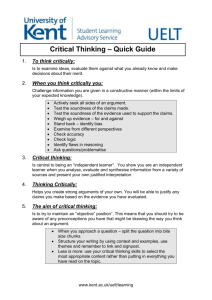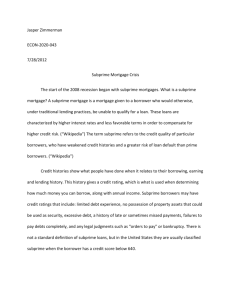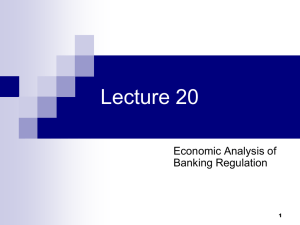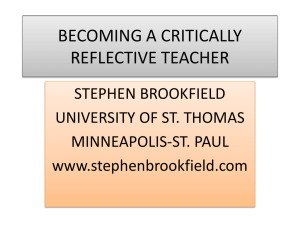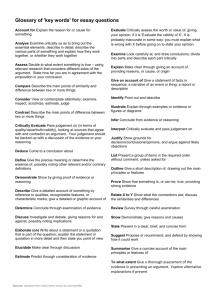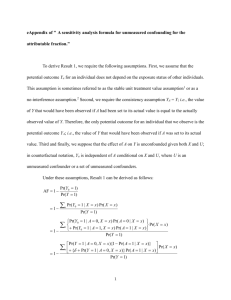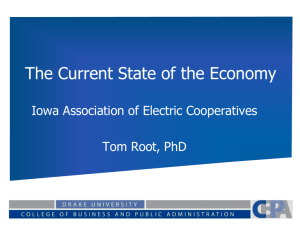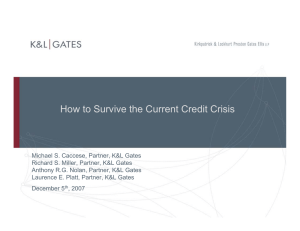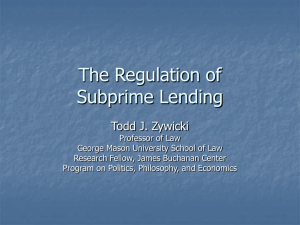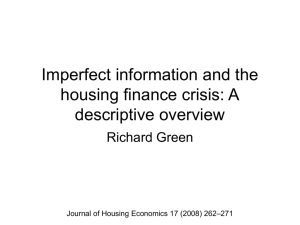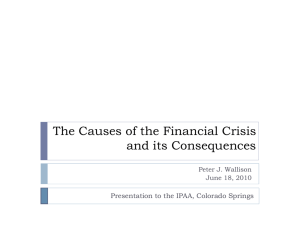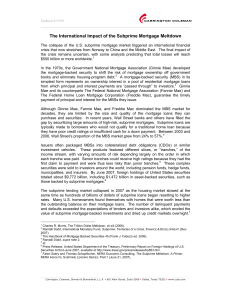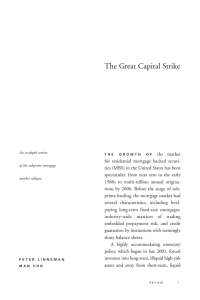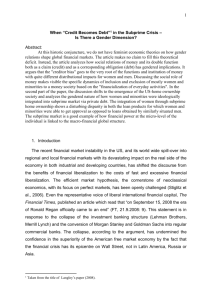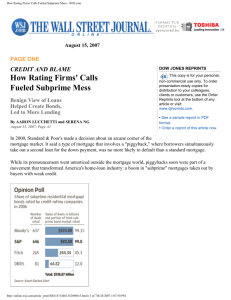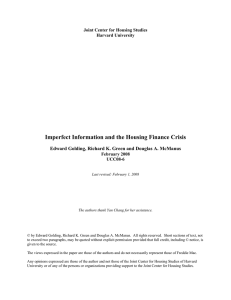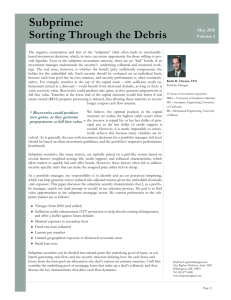A Practical Definition for the Teaching and Assessment of Critical
advertisement
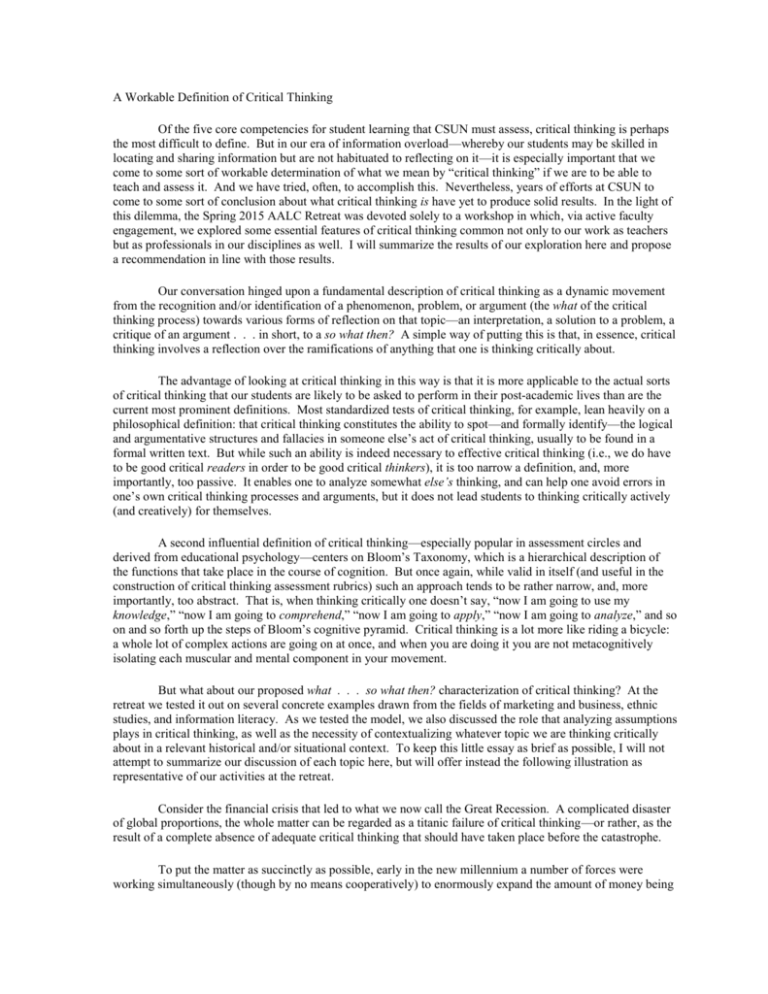
A Workable Definition of Critical Thinking Of the five core competencies for student learning that CSUN must assess, critical thinking is perhaps the most difficult to define. But in our era of information overload—whereby our students may be skilled in locating and sharing information but are not habituated to reflecting on it—it is especially important that we come to some sort of workable determination of what we mean by “critical thinking” if we are to be able to teach and assess it. And we have tried, often, to accomplish this. Nevertheless, years of efforts at CSUN to come to some sort of conclusion about what critical thinking is have yet to produce solid results. In the light of this dilemma, the Spring 2015 AALC Retreat was devoted solely to a workshop in which, via active faculty engagement, we explored some essential features of critical thinking common not only to our work as teachers but as professionals in our disciplines as well. I will summarize the results of our exploration here and propose a recommendation in line with those results. Our conversation hinged upon a fundamental description of critical thinking as a dynamic movement from the recognition and/or identification of a phenomenon, problem, or argument (the what of the critical thinking process) towards various forms of reflection on that topic—an interpretation, a solution to a problem, a critique of an argument . . . in short, to a so what then? A simple way of putting this is that, in essence, critical thinking involves a reflection over the ramifications of anything that one is thinking critically about. The advantage of looking at critical thinking in this way is that it is more applicable to the actual sorts of critical thinking that our students are likely to be asked to perform in their post-academic lives than are the current most prominent definitions. Most standardized tests of critical thinking, for example, lean heavily on a philosophical definition: that critical thinking constitutes the ability to spot—and formally identify—the logical and argumentative structures and fallacies in someone else’s act of critical thinking, usually to be found in a formal written text. But while such an ability is indeed necessary to effective critical thinking (i.e., we do have to be good critical readers in order to be good critical thinkers), it is too narrow a definition, and, more importantly, too passive. It enables one to analyze somewhat else’s thinking, and can help one avoid errors in one’s own critical thinking processes and arguments, but it does not lead students to thinking critically actively (and creatively) for themselves. A second influential definition of critical thinking—especially popular in assessment circles and derived from educational psychology—centers on Bloom’s Taxonomy, which is a hierarchical description of the functions that take place in the course of cognition. But once again, while valid in itself (and useful in the construction of critical thinking assessment rubrics) such an approach tends to be rather narrow, and, more importantly, too abstract. That is, when thinking critically one doesn’t say, “now I am going to use my knowledge,” “now I am going to comprehend,” “now I am going to apply,” “now I am going to analyze,” and so on and so forth up the steps of Bloom’s cognitive pyramid. Critical thinking is a lot more like riding a bicycle: a whole lot of complex actions are going on at once, and when you are doing it you are not metacognitively isolating each muscular and mental component in your movement. But what about our proposed what . . . so what then? characterization of critical thinking? At the retreat we tested it out on several concrete examples drawn from the fields of marketing and business, ethnic studies, and information literacy. As we tested the model, we also discussed the role that analyzing assumptions plays in critical thinking, as well as the necessity of contextualizing whatever topic we are thinking critically about in a relevant historical and/or situational context. To keep this little essay as brief as possible, I will not attempt to summarize our discussion of each topic here, but will offer instead the following illustration as representative of our activities at the retreat. Consider the financial crisis that led to what we now call the Great Recession. A complicated disaster of global proportions, the whole matter can be regarded as a titanic failure of critical thinking—or rather, as the result of a complete absence of adequate critical thinking that should have taken place before the catastrophe. To put the matter as succinctly as possible, early in the new millennium a number of forces were working simultaneously (though by no means cooperatively) to enormously expand the amount of money being lent on mortgage and home equity loans. This is our what, and it must be made clear before going any further. Part of that clarification lies in determining the causes of this huge growth in housing-based lending. This requires some historical contextualization, which reveals a number of interacting causes. First, the federal government was encouraging home loans both to stimulate the economy after the dot.com bust and the 911 stock marker crash, and also to provide an avenue, via home ownership, into the middle class for working class borrowers (usually categorized as “subprime”). Second, governmental incentives, along with new ways of marketing mortgage debt (for example, collateralized debt securities) made the home loan markets attractive to a financial services industry that had been deregulated to the extent of vastly enlarging the range of active lenders. And third, rising real estate values, after a period of declining stock prices, made real estate an attractive investment for home buyers, while at the same time offering existing home owners opportunities to borrow on their rising equity. The cumulative effect of these causes was a flood of money cascading into the housing markets. And here is where some so what then? thinking should have, but didn’t, take place, and it can begin at the level of evaluating the assumptions behind all three causative factors. First, and most crucially, there was a common assumption shared by governmental policy makers, lenders, and borrowers alike: it was, quite simply, that the world had changed and that home prices could not decline and must always rise. A second, more limited but influential assumption held by large numbers of economists, was the “rationalist” view (made popular by such economists as Milton Friedman) that rational investors would never pay more for a commodity than it was worth. This assumption had the effect of allaying fears of a bubble housing market, and helped set the stage for catastrophe. These two assumptions were basically taken for granted, but two simple acts of critical thinking could have revealed their flaws. The first critical action would have been to situate the housing market of the early 21st century in a broader historical context, which would have shown one boom-and-bust housing cycle after another in just the past few decades. Enlarging the contextualization, one could have seen the fate of many a speculative boom—from tulips to profitless dotcom startups with multi-billion dollar stock valuations—as a warning against making assumptions about invariably increasing market valuations, not to mention against relying on the rationality of investors. A third assumption that called for some critical thinking that never happened underpinned the activities of the collateralized debt markets. This was the assumption that if subprime mortgage borrowers defaulted on their loans (indeed, many subprime loans were practically designed to lead to default due to built-in schedules of dramatically rising interest payments) their houses could be sold off for a nice profit (remember, the first assumption was that housing values could only rise). It looked like a win-win situation for investors, but no one appears to have considered a certain ramification (or so what then?) of the huge number of subprime loans that were being made at the time: namely, that should defaults in the subprime market begin, there would soon be too many repossessed houses on the market to maintain the high prices that were holding the whole house of cards up in the first place. Which is precisely what (quite foreseeably) happened. Our analysis reveals a number of generalizable features. One, that critical thinking moves from a what to a so what then? reflection. Two, that this reflection involves historical (and other factual) contextualization. Three, that the causes of a phenomenon are often multiple, or overdetermined. Four, that critical thinking requires an analysis of assumptions (one’s own as well as those of others). And five, that critical thinking is not an empty formal process: it requires content knowledge of the sort of wide range that a well constructed General Education program should provide (to put this another way, even a class that does not explicitly teach critical thinking as such can contribute to the development of critical thinking skills by providing students with the diverse range of knowledge that is necessary to sound critical thinking). It can be added that this view of critical thinking embraces the Peircean logical principle of abduction—that is, the idea that we are always seeking the most likely explanations for whatever phenomena we are thinking critically about, rather than seeking some sort of impossible standard of absolute proof. Thinking about critical thinking in this way can provide us with a model that could serve as a common ground for both teaching and assessment, while preparing our students for the kind of tasks they are most likely encounter in their post-CSUN lives.
